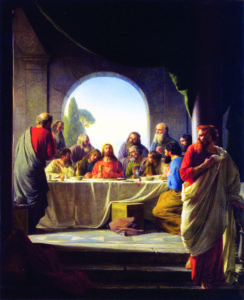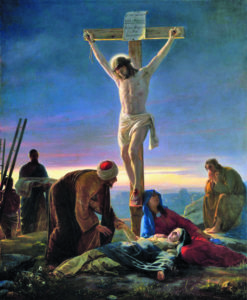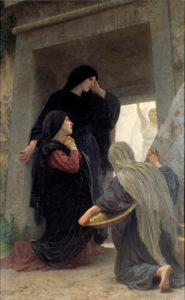The Easter Triduum
 Triduum means three days of prayer. What binds together the three days of the Easter Triduum -- Holy Thursday, Good Friday and the Easter Vigil -- is that all of them are Easter. Each, in their way, celebrates Christ's dying and rising from the dead.
Triduum means three days of prayer. What binds together the three days of the Easter Triduum -- Holy Thursday, Good Friday and the Easter Vigil -- is that all of them are Easter. Each, in their way, celebrates Christ's dying and rising from the dead.
The liturgy does not, in fact, separate Our Lord’s death and resurrection. Easter is never just the resurrection, and the passion of the Lord is never only death; always, the death and resurrection go together.
Holy Thursday – the Mass of the Lord’s Supper
We find the essence of the Holy Thursday celebration in the Gospel reading, which describes the washing of the feet, a striking symbol of the meaning of the Eucharist. The foot washing is a potent reminder that our God is a loving servant who calls us to serve others as he serves us. We are reminded that the Eucharist is lived out and made real in acts of loving service. The challenge for us is to strip ourselves to wash the feet of the "little ones". In this way, we renew our covenant with God "who hears the cry of the poor". The covenant is made present in the form of a meal, as it was and is for the Jewish covenant celebrated in the Passover meal.
Christ is present in the liturgical celebration, which brings a past reality into the present so that we can enter into it. We proclaim and re-present what Jesus did at the Last Supper.
The Gospel reading presents us with John's version of the Last Supper. The second reading puts Paul's version before us. The Eucharistic Prayer contains a combination of Matthew's, Mark's, Luke's and Paul's accounts of the Last Supper. Thus, Holy Thursday comes to life in our lives.

Christ on the Cross, Carl Bloch, 1870
Good Friday – the Celebration of the Lord’s Passion
The readings from scripture and the prayers on Good Friday celebrate the joy of the suffering servant who sees the light of victory. The ceremony is not a funeral; rather, it's the celebration of a holy people, a chosen race, a royal priesthood whose King reigns from the Cross.
The ceremony presents Easter in terms of Jesus’ victory on the Cross. The key to understanding the Good Friday ceremony is found in the reading of the Passion from St John's Gospel. Jesus is seen as being in control of the situation. He is not a helpless victim. The Cross is glory, victory over the forces of sin and evil and death. The Cross is a symbol of self-giving love for God and God's people, "I" crossed out.
We venerate the Cross as a symbol of that love for us. It is good for us to remember that our veneration of the Cross has meaning only insofar as we give ourselves in love for others.
It is called 'Good' Friday because it was the day on which goodness and love defeated evil and sin.
The ceremony on Good Friday begins in the silence that marked the end of the Holy Thursday ceremony and joins Good Friday to Holy Thursday. The silence at the end of the Good Friday liturgy joins it to the silence at the beginning of the Easter Vigil on the evening of Holy Saturday.

The Holy Women at the Tomb, William-Adolphe Bouguereau, 1890
Holy Saturday – the Time of Waiting to Celebrate the Resurrection
St Augustine described the Easter Vigil as “the Mother of all Vigils”. The dictionary meaning of the word is helpful: “a period of keeping awake during the time usually spent asleep, especially to keep watch or pray”. We wait and watch, with the catechumens, and with all those who wait and watch for Jesus to rise from the dead.
The Easter Vigil presents the Risen Christ as the Light of the World, in whom we die and rise to eternal life through Baptism.
The ceremony begins in darkness, the paschal candle takes light from the Easter fire, and we praise the candle's light as if it were Christ. This night is the night of salvation. Rescued from the slavery of sin, we remember Israel escaping from Egypt and the disciples rejoicing. We gather for the Vigil because we are already the community of the resurrection, the community of the Church re-created.
The ceremony moves from celebrating the Light of Christ to the Word of God. Then the Waters of Baptism are blessed, and we call to mind the meaning and the challenge of our being baptised by renewing our Baptism vows. Then, we join in the offering of the Easter Eucharist. We receive the risen Lord in Holy Communion. He empowers us for mission, giving us his power to change the world for the better.
 Entries(RSS)
Entries(RSS)